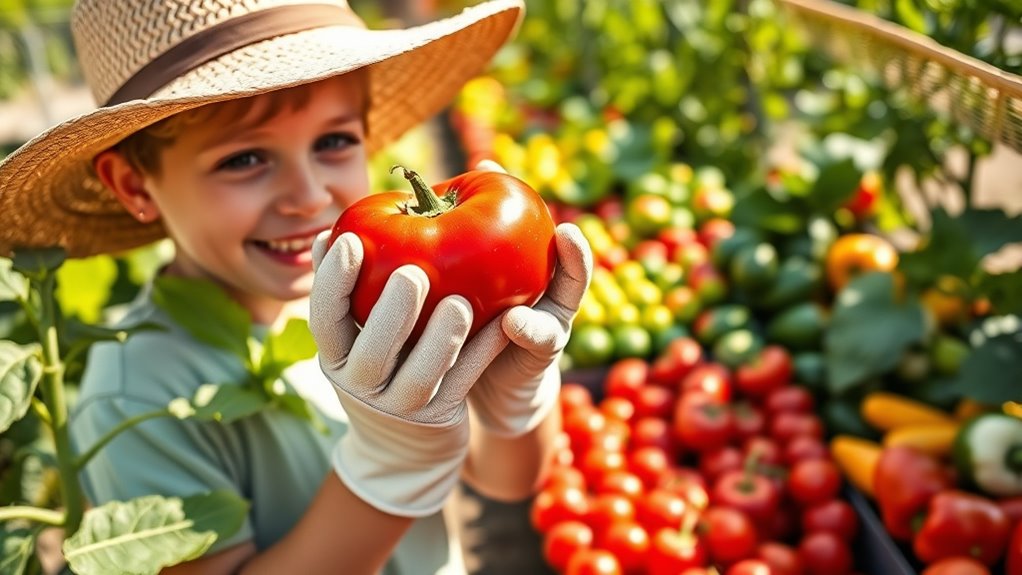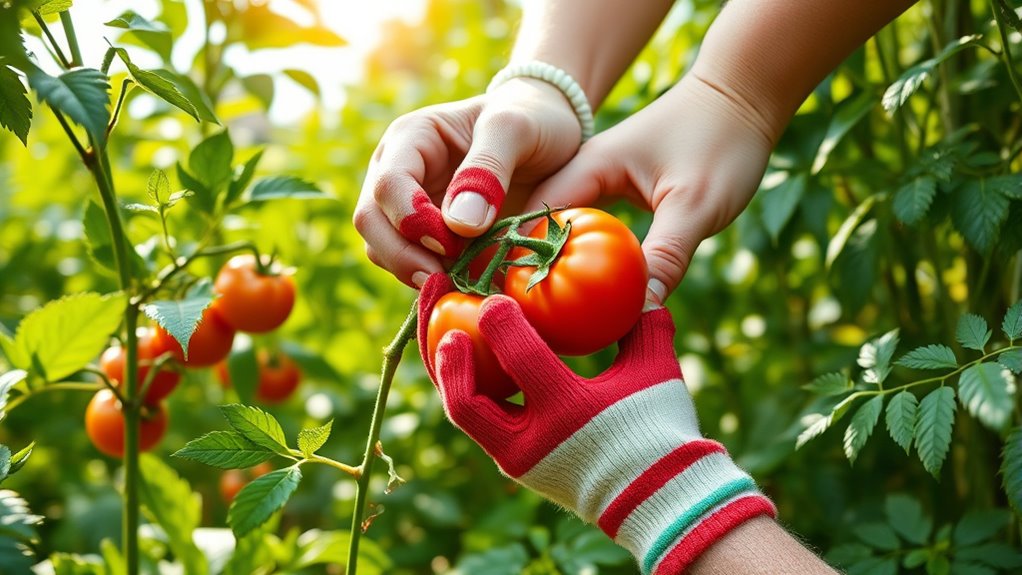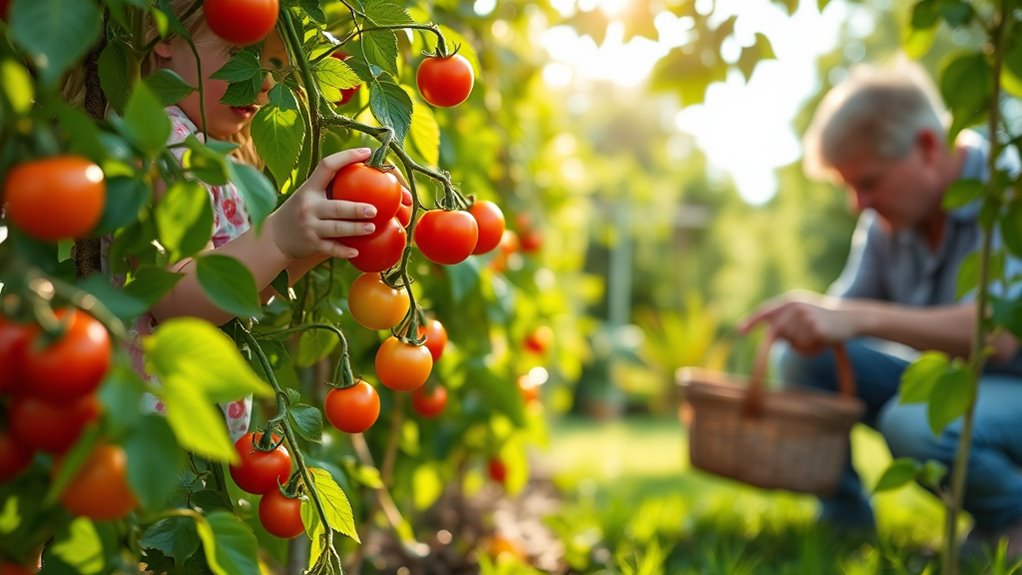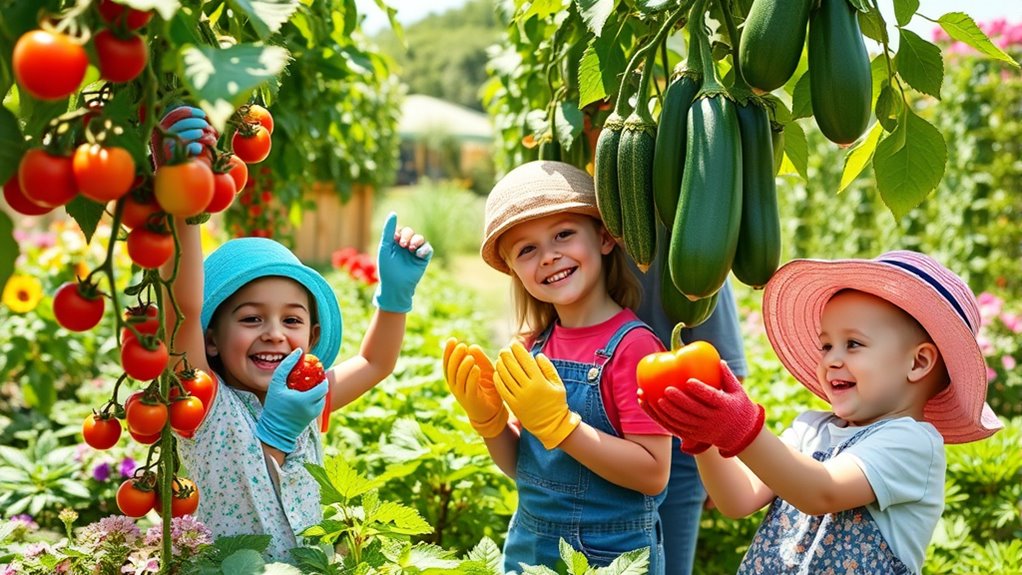To teach kids to pick garden produce safely, start by showing them appropriate, child-sized tools with safety features. Explain how to identify ripe, healthy fruits using color, firmness, and size, and teach gentle harvesting techniques to prevent damage. Emphasize good hygiene with handwashing before picking, and stress the importance of patience for proper ripening. Make it fun with games and activities that promote respect for plants while helping them develop safe harvesting habits. Keep going to learn more!
Key Takeaways
- Teach children to use child-sized, ergonomically designed tools with safety features like blunt blades and non-slip grips.
- Show how to identify ripe produce through color, firmness, and size, and use gentle handling techniques.
- Encourage responsible harvesting by taking only what is needed and supporting plant health.
- Emphasize proper hygiene, including thorough handwashing before and after harvesting.
- Incorporate fun activities like garden games to promote safe, attentive, and respectful harvesting habits.
Choosing the Right Tools for Young Gardeners

When teaching kids to pick garden produce, choosing the right tools is essential to guarantee safety and ease. Child-sized gardening tools are designed specifically for little hands, making gardening safer and more comfortable. These tools help prevent accidents by reducing the risk of slips or cuts, ensuring better garden tool safety. Look for lightweight, ergonomically designed tools with blunt blades or rounded edges. Avoid adult-sized tools, which can be unwieldy and unsafe for children. Using proper, appropriately-sized tools encourages independence and confidence in young gardeners. Plus, it keeps their hands protected and makes the gardening process more enjoyable. Prioritizing child-sized gardening tools sets a strong foundation for safe, effective, and fun gardening experiences for kids. Incorporating tool safety features like non-slip grips and protective guards further enhances safety during gardening activities.
Teaching Kids How to Identify Ripe and Safe Produce

Teaching kids how to identify ripe and safe produce is a crucial step in fostering their independence and ensuring they enjoy the fruits of their labor safely. Start by explaining fruit maturity, such as knowing when tomatoes are fully colored or zucchinis feel firm. Show them how to look for pest signs, like holes or chewed leaves, which indicate potential contamination. Encourage your kids to observe color changes, firmness, and size as clues to ripeness. Teach them that produce with blemishes or pest damage might not be safe to eat. Reinforce the importance of inspecting produce carefully before picking. By understanding these visual and tactile cues, kids learn to pick only safe, ripe fruit, building confidence and promoting safe harvesting habits in the garden. Regularly discussing pest signs with your children can help them develop a keen eye for safe produce.
Demonstrating Proper Picking Techniques to Avoid Damage

Show kids how to use gentle hand movements when picking produce to prevent damage. Teach them to look for ripe fruits and vegetables that are ready to harvest. Remind them not to overharvest, so plants can continue to grow and thrive. Incorporate mindful harvesting practices to help children develop respect for the plants and understand the importance of sustainable gardening.
Use Gentle Hand Movements
Using gentle hand movements is essential for preventing damage to your garden produce. When you pick fruits or vegetables, use a gentle touch and a soft grip to avoid bruising or breaking delicate items. Encourage kids to handle produce with care, supporting the stem or base rather than squeezing tightly. Teach them to slow down and approach each item carefully, ensuring they don’t yank or pull too hard. A gentle hand helps maintain the integrity of the produce and promotes healthy growth for future harvests. Remind children to be mindful of their movements and to treat each plant with respect. With practice, they’ll develop a natural sense of how to pick produce carefully, making the experience both safe and enjoyable for everyone involved. Incorporating proper handling techniques can further improve their confidence and skills in harvesting safely.
Identify Ripe Produce
Before picking produce, it’s important to recognize when fruits and vegetables are ripe and ready for harvest. Ripeness indicators vary by crop, such as color, size, and firmness. For example, tomatoes should be fully colored without green patches, while zucchinis reach ideal harvest timing when they’re firm and shiny. Teach kids to observe these signs carefully, avoiding guesswork. Properly identifying ripe produce ensures a good harvest and prevents damage to plants. Remind them to check each fruit or vegetable gently, using their eyes and hands. By understanding ripeness indicators, kids learn to pick at the right time, minimizing waste and promoting healthy plant growth. This careful approach sets the foundation for safe, effective harvesting practices.
Avoid Overharvesting
To prevent harming plants and guarantee healthy growth, it’s vital to teach kids how to pick produce carefully without overharvesting. Show them proper harvest etiquette by only taking what they need and leaving enough for the plant to continue thriving. Emphasize that overharvesting can weaken plants, reduce future yields, and disrupt plant stewardship. Encourage them to gently grasp the produce and use scissors or pruning shears when necessary, avoiding tearing or pulling. Explain that harvesting should be done selectively, removing ripe fruits or vegetables without stripping the plant. Reinforce that respecting the plant’s health helps ensure a productive garden for seasons to come. By practicing these techniques, kids learn responsible harvesting habits that support plant health and sustainability. Incorporating natural materials into their gardening routines can also help children develop a deeper appreciation for the environment and the importance of sustainable practices.
Emphasizing Hygiene and Handwashing Before Harvesting

Ensuring kids wash their hands thoroughly before harvesting is essential for maintaining garden hygiene and preventing the spread of germs. Teaching proper hand hygiene helps reduce the risk of contaminating fruits and vegetables with dirt, bacteria, or other pathogens. Make handwashing a routine part of your garden activities by showing kids how to use soap and water effectively, scrubbing for at least 20 seconds. Reinforce sanitation practices, like cleaning hands before touching produce, to promote healthy habits. Remind children that clean hands protect their health and make the harvest safer for everyone. Incorporating this step into your garden routine ensures that hygiene is prioritized, making the harvesting process safer, cleaner, and more enjoyable for kids. Proper hygiene practices are essential for safeguarding health and ensuring safe harvesting.
Explaining the Importance of Timing and Patience

Teaching kids to recognize when fruits and vegetables are ripe helps them understand the importance of timing. Practicing patience daily shows them that good things take time and care. When they see the signs of ripening, they’ll learn to wait for the perfect moment to harvest safely. Incorporating digital literacy tools can also help children learn about digital safety and responsibility, which is essential in today’s connected world.
Recognize Ripening Signs
Recognizing the signs of ripening is key to harvesting garden produce at its best flavor and freshness. One of the most obvious indicators is fruit ripeness, which often involves noticeable color changes. As fruits near readiness, they shift from green to shades of yellow, orange, red, or other vibrant hues. For vegetables like peppers or zucchinis, look for size and a firm texture rather than color alone. Pay close attention to these visual cues, as picking too early can lead to less flavorful produce, while waiting too long might cause spoilage. Teaching kids to observe these ripening signs helps them develop patience and ensures they harvest at the perfect moment, preserving the taste, texture, and nutritional value of your garden’s bounty. Understanding ripening stages can further enhance their ability to make timely, safe harvest decisions.
Practice Patience Daily
Practicing patience daily is essential because harvesting too early or too late can compromise the quality of your garden produce. Mindful waiting guarantees you pick fruits and vegetables at their peak ripeness, preserving flavor and nutrients. Teach your kids that patience helps prevent damage; rushing can lead to bruising or breaking delicate produce. Encourage gentle handling during harvest, showing kids how to carefully grasp and lift fruits, avoiding unnecessary pressure. Emphasize that good timing results in better-tasting, healthier food. By modeling patience and mindful waiting, you help kids understand that good things take time. This approach fosters respect for the garden and patience as a valuable skill, making harvesting a rewarding and safe experience for everyone involved.
Encouraging Responsible Harvesting and Respect for Plants

To foster a sense of responsibility and respect for plants, it’s important to teach kids that harvesting is a privilege, not just a task. Explain that careful picking supports healthy plant care and pest prevention, helping the garden thrive. Show them how to select ripe produce gently, avoiding damage to stems or leaves, which can invite pests or disease. Emphasize that harvesting thoughtfully respects the plant’s effort and encourages future growth. Encourage kids to observe plants regularly, noticing signs of ripeness and understanding how their actions impact the garden’s health. By teaching responsible harvesting, you help them develop respect for nature and understand that caring for plants requires attention, patience, and kindness. Recognizing the importance of float mounting textile art in presentation can inspire creative ways to display their harvests or garden-inspired crafts. This builds a lifelong appreciation for gardening and sustainable practices.
Making the Learning Experience Fun and Engaging

Turning responsible harvesting into a fun activity keeps kids enthusiastic to participate and learn. To make it engaging, incorporate garden games that challenge their skills and knowledge. For example:
Turning harvest time into fun garden games keeps kids excited and eager to learn.
- Harvest Scavenger Hunt – Find specific vegetables or herbs, making learning active.
- Garden Bingo – Spot different produce and mark them off on cards.
- Fruit and Veggie Relay – Carry harvests carefully in a relay race.
- Fun Harvests – Celebrate with a mini picnic after collecting the best produce.
These activities turn simple picking into memorable experiences. They promote teamwork, focus, and respect for the garden, all while keeping kids excited about gardening. Incorporating garden safety practices helps ensure that children learn to harvest responsibly and without accidents. With garden games, your little helpers will look forward to fun harvests every time.
Frequently Asked Questions
How Can I Teach Kids to Recognize Common Garden Pests Safely?
To teach kids pest identification and safe pest removal, start by showing them common garden pests and explaining how to recognize signs of damage. Use kid-friendly guides or pictures to help them identify pests accurately. Emphasize gentle, safe pest removal methods like handpicking or using natural deterrents. Encourage curiosity and patience, and supervise their actions to make certain they practice safe pest removal and understand why avoiding harmful chemicals is important.
What Safety Gear Should Children Wear While Harvesting?
When kids are harvesting, you want them to stay safe, so make sure they wear garden gloves to protect their hands from dirt and potential irritants. A wide-brimmed hat is also essential to shield their face and neck from the sun. Encourage them to wear sturdy shoes and long sleeves for extra protection. This gear keeps them comfortable and safe while they enjoy harvesting their garden produce.
How Do I Handle Kids’ Questions About Eating Raw Garden Produce?
When kids ask about eating raw garden produce, explain the importance of garden hygiene and how to tell edible from inedible plants. Encourage them to wash all produce thoroughly before eating and remind them some plants aren’t safe to eat, even if they look tempting. Keep the conversation positive, and teach them to ask an adult if they’re unsure about a plant’s safety, fostering curiosity and safe habits.
What Are Some Signs of Produce That Shouldn’t Be Harvested Yet?
To identify when produce isn’t ready for harvest, look for ripeness indicators like color, size, and firmness. For example, tomatoes should be fully colored and slightly soft, while zucchinis need to reach their mature size. Harvest timing is key—if fruits or vegetables aren’t ripe, they won’t taste their best or develop full flavor. Teach kids to observe these signs so they understand when to pick for the best quality.
How Can I Encourage Kids to Share Their Harvest Responsibly?
You might think kids won’t want to share their harvest, but encouraging sharing responsibilities helps them feel proud and involved. Celebrate harvests together by dividing produce fairly and praising their effort. Make it fun by creating a garden “treasure” game or a small market. This approach teaches them the value of teamwork, responsibility, and generosity, turning the harvest into a joyful, shared experience everyone looks forward to.
Conclusion
By teaching kids to pick garden produce safely, you’re planting seeds of responsibility and curiosity that grow stronger each day. Imagine their tiny hands as gentle gardeners, nurturing a vibrant, living tapestry of fruits and vegetables. With patience, practice, and a touch of fun, you’ll help them develop skills that last a lifetime. Together, you’re cultivating not just a garden, but a future rooted in respect, safety, and love for nature’s bounty.








